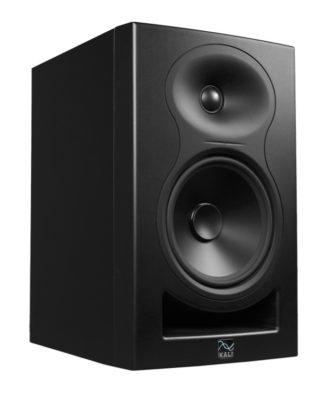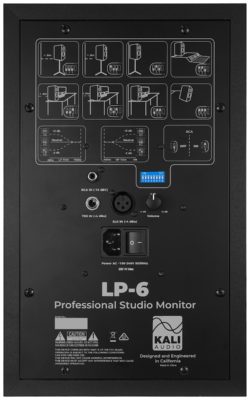New Gear Review: LP-6 Studio Monitors by Kali Audio

Brand new to the scene, Kali Audio makes a strong debut with the Project Lone Pine studio monitors, featuring the LP-6 and LP-8 models.
Founded in January of 2018, Kali Audio is a brand new company. Their debut product line, the Project Lone Pine studio monitors, have been piquing the interest of industry professionals since their release.
Project Lone Pine currently offers 2 models of speakers: the LP-6 6.5-inch studio monitor, and the LP-8 8-inch studio monitor. Both offer a wealth of intriguing features that are sure to set Kali aside from other speaker manufacturers.
The monitors I’ll be reviewing are Kali’s LP-6s, which I’ll also be comparing to a pair of Yamaha HS8s. I was initially planning to compare the LP-6s to a set of Yamaha HS5s, but Nate Baglyos of Kali Audio suggested that a comparison to Yamaha’s larger model would be more fair. Let’s see how they stack up.
Features
The LP-6 includes some impressive features. The first of these is a waveguide that aims to create a soundstage that is wider, deeper, and taller than the speakers themselves. The result of this is a larger listening “sweet spot.”
Next up is the low-noise front port tube. Many speakers run into an issue known as “chuffing,” which is the annoying sound of air leaving the monitor at different velocities. This can make it difficult to tell what’s going on in the low-end of your mix. The port tube on the LP-6 is designed in a way that allows all the air within it to leave at the same velocity, which effectively reduces chuffing and will enable you to mix low-end more accurately.
Moving along, the LP-6 offers a high dynamic range with low distortion, thanks to its dual-layer, 1.5” voice coil. It includes a 6.5” woofer, and 1” soft dome tweeter. Additionally, it promises high output with 85 dB continuous output at 2 meters, 20 dB of headroom, and a max SPL of 108 dB. This means that whether you’re using the LP6s in a small home or large-scale professional studio, you’ll have plenty of gain and headroom to work with.
The most exciting feature on the LP-6 is the boundary EQ that it offers. This allows you to adjust the frequency response of the monitors, making them suitable for use on stands, mixing consoles, and desks, while positioned either close to, or far away from walls. The back of the monitors have 8 different graphics that clearly lay out recommended boundary EQ settings for various placements. When you toss in the low- and high-frequency trim controls, it becomes quite easy to tailor the monitors to the needs of your room.
The LP-6 includes balanced XLR and TRS inputs. Additionally, there’s an RCA input that you can set to -10 dBu sensitivity to accommodate the connection of consumer devices, such as computers, iPhones, etc. Powering the unit is a Class-D power amp, which is quite common on studio monitors, meaning that all of the connections into the monitors are easily replaceable if necessary.
In Use
After spending some time with these monitors, I found they gave the Yamaha HS8s a run for their money. However, I noticed a few key differences in my time with the LP-6s.
As advertised, the LP-6s have quite a large “sweet spot” that you can move around in while mixing due to their waveguide. Additionally, they produce a very clean low-end that the Yamaha’s tend to lack. The most noticeable difference I found was in the clarity of mid- to high-frequency content between the Kali’s and the Yamaha’s. I found that it was slightly more difficult to pinpoint certain elements in the mix when using the Kali monitors, and the Yamaha’s tended to pull elements apart from one another marginally better. However, the differences were subtle, and it’s hard to justify how the HS8s cost almost twice than that of the LP-6s.
I actually asked Baglyos about how they’re capable of providing a monitor of such quality at such a low price point. He said that “The challenge of designing the Lone Pine monitors was figuring out how to keep costs low without compromising on acoustic performance. Ultimately this came down to a mix of innovation and math. Innovation to figure out how to make features like the waveguide and port tube that make the system sound great without adding cost. Math to exploit the full performance of both the woofer and the amplifier so that the people using these aren’t paying for components that are never fully utilized.”
I think that the way Kali Audio has been able to reduce cost by creating a product with a unique design is ingenious. We’re so used to paying more for a better product that paying less seems unheard of. This emphasis on affordability streams down right into Kali’s studio monitor packaging. They ship in a plain, uncolored cardboard box, which further saves costs, and has no affect on the performance of the monitors.
To Be Critical
It’s quite hard to criticize studio monitors in this price range that completely stomp on many of their similarly priced and similarly sized competitors. Kali Audio must have done some serious market research because they seem to have not only tried to address many issues found in other similarly priced monitors, but succeeded in doing so.
It would have been nice if the switches for the boundary EQ, high/low-frequency trim controls, and the RCA sensitivity were slightly larger. If you have big fingers, you may need to use a little tool to flip these switches. However, a boundary EQ is rather scarce in this price range, so having access to it at all is actually remarkable. An increase in the size of the switches would very likely increase the overall price of the unit as well.
Summing it Up
If a company wants to break into an industry, they need to provide a product that is either cheaper or better than their competition. With the LP-6s priced at just $149 each, Kali Audio has succeeded in creating a studio monitor that stacks up remarkably well against other monitors well beyond its price range. In addition, Kali Audio has solidified themselves as not only a contender in the pro studio monitor market, but a frontrunner in studio monitor technology and advancement.
By fusing deep market research with math and creative design techniques, Kali Audio has been able to produce a monitor that performs exceptionally well, while remaining within the budget of the home recording enthusiast. The LP-6s will also sit comfortably alongside a set of main monitors in top-end studios. They are incredibly versatile and are undoubtedly going to make waves in the pro audio industry.
Charles Hoffman is a Mixing and Mastering Engineer at Black Ghost Audio. After graduating from the University of Manitoba with an English degree, Charles completed his education at Icon Collective in Los Angeles, CA.
Please note: When you buy products through links on this page, we may earn an affiliate commission.







